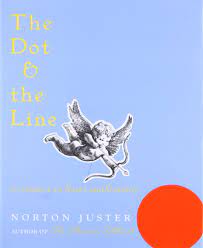Chances are that you know the author, Norman Juster, from his outstanding book, "The Phantom Tollbooth." What many people don't realize is that he created this classic book also in 1968, which was turned into an Academy Award winning short film. This book is a delight at many levels, and it is the perfect opportunity for adults and children to read and discuss together! Even though this book is indicated for the 4-8 year old group, younger children will love it, too, and the ideas in it are fascinating for adults. So, you should probably think of this as a book for "children of all ages."
You can read this book primarily from several different perspectives. It may be easier for you child if you emphasize one at a time when you introduce the book. First, there's the classic love "triangle" involving a line (a rather straight fellow) who falls for a circle, the circle (who's frivolous despite being perfectly identical in all directions -- "You're the beginning and the end, the hub, the core and the quintessence . . . ."), and a messy squiggle of a line who appeals to the dot (who the dot thinks is "gay and free, so uninhibited and full of joy"). This story line is the easiest for everyone to follow.
Although the line is rather dependable and like-able, he's just not interesting to the circle (". . . and you are as stiff as a stick. Dull. Conventional and repressed. Tied and trammeled. Subdued, smothered and stiffled."). So he goes off to "learn new tricks" and creates the ability to make an infinite number of shapes out of his line. She's impressed, and that wins the fair maiden.
The next level at which people can understand the book is to appreciate that lines can form parts of objects (like a tightrope, a lance, the equator, or a tug of war rope). If you create angles in a line, you can create all sorts of wonderful shapes from a triangle on up to very complex geometric solids. These are described by name, so this is a flying start for geometry and trigonometry later on. If you curve the line, you can create magnificent shapes of soaring grandeur. Here's where the vocabulary goes way beyond what a 4-8 year old can handle. But that's where you can be the intelligent adult who helps out. This interpretation would be wonderful for a classroom discussion also.
The third level of the book relates to the mathematical expressions behind how you turn a line into a curve or create an angle. The book has the illustrations present for this interpretation, but not the discussion. If you understand how these shapes can be described mathematically, you can make that connection for your child.
The puns themselves are worth the cost of the book. I won't give you any examples because I don't want to spoil them, but some minor ones do show up in the quotes above. The puns take turns aiming in different directions to expand the perspective the reader has on words as sources of character comments, descriptions about physical characteristics, and plastic qualities.
One of the great sections of the book is where the circle begins to appreciate the differences between purposeful shapes and random ones. "And she suddenly realized that what she thought was freedom and joy was nothing but anarchy and sloth." This is an important section because it releases the concept of mathematics as purposeful freedom to the reader. Anyone who "gets" that message is likely to have a much easier and happier time pursuing mathematics as the delightful mental discipline that it is.
If your child takes to this material, I suggest that you might follow up with some more advanced discussions about math. Either "The Birth of the Algorithm" or "Just Six Numbers" could be read by you and then translated into age-level appropriate examples and discussions to connect math to science. This would be a wonderful gift to give to any child.
Appreciate the potential of pure numbers . . . infinitely!

 RSS Feed
RSS Feed